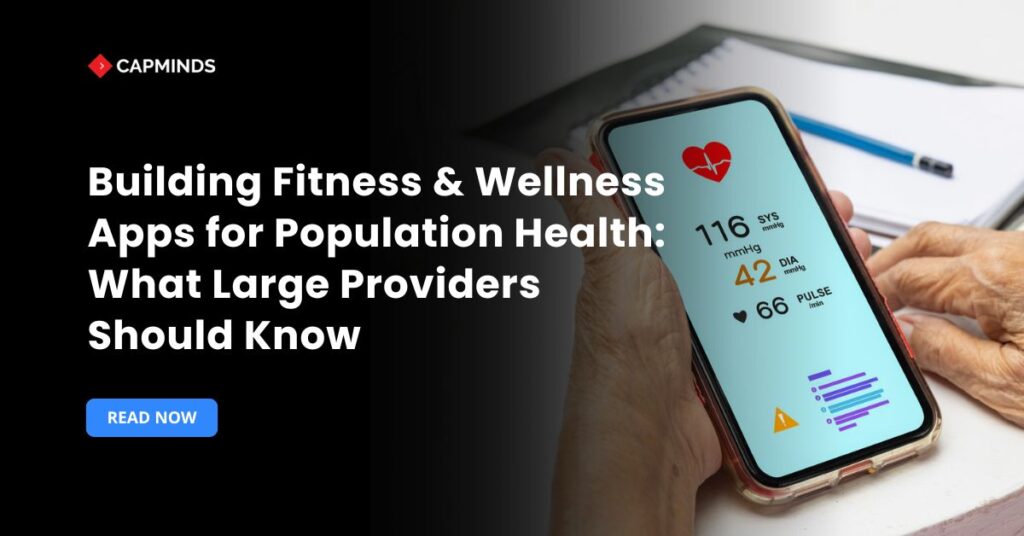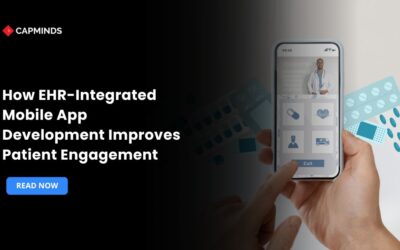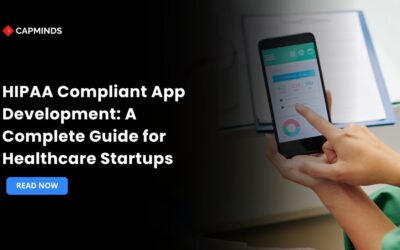Building Fitness & Wellness Apps for Population Health: What Large Providers Should Know
Fitness and wellness apps are rapidly becoming strategic tools for healthcare organizations aiming to improve outcomes under value-based care. In this context, healthcare app development services and modern digital health mobile app solutions extend preventive and chronic care beyond the clinic, engaging patients in healthy behaviors, gathering continuous health data, and improving population health metrics.
In value-based environments, wellness apps help align care delivery with quality and cost goals, reducing hospitalizations, boosting wellness, and securing performance-based payments. For example, focusing on preventive care and chronic disease self-management has been shown to significantly improve population health outcomes while containing costs.
Equally important, engaging patients with personalized fitness and nutrition plans leads to stronger adherence and lifestyle change.
In short, fitness and wellness apps transform how large providers meet value-based care goals, augmenting traditional services with real-time, patient-generated data and continuous engagement.
To realize these benefits, providers should ensure their wellness solutions include the right features, comply with regulations, and integrate smoothly into the health IT ecosystem. The following sections explore the strategic importance, core capabilities, security and regulatory requirements, and integration considerations for fitness and wellness apps in population health.
Strategic Role in Value-Based Care and Population Health
In a value-based model, health systems are rewarded for keeping populations healthy rather than for the volume of services provided. Wellness apps support this paradigm in several ways:
1. Preventive Care and Better Outcomes
Apps can deliver personalized exercise programs, nutrition guidance, and lifestyle coaching to reduce disease risk. By focusing on prevention and chronic care management, health systems can “significantly improve the health outcomes of populations”.
For example, regular activity tracking and coaching have been linked to higher rates of meeting exercise guidelines and lower incidence of chronic conditions.
2. Cost Reduction
Digital wellness tools help delay or avert expensive interventions. Health IT leaders note that population health programs leveraging technology achieve cost savings by preventing disease progression and minimizing hospital readmissions. Engaging patients early and catching health issues sooner leads to fewer emergency visits and inpatient stays.
3. Patient Engagement and Adherence
Apps empower individuals to take charge of their health. Engaged patients, those tracking their fitness and health metrics, are more likely to stick with care plans. As Validic observes, “engaging patients in their care leads to better adherence to treatment plans and healthier lifestyles”.
In practice, patients using wellness apps report higher medication adherence and improved control of conditions like diabetes or hypertension.
4. Data-Driven Care
Wellness and fitness apps generate vast amounts of patient-generated health data (PGHD) from wearables, sensors, and self-report tools. Providers can use this data for risk stratification and to tailor interventions.
Importantly, PHM “relies heavily on data to make informed decisions”, and wellness apps supply real-time, continuous data that enrich clinical insights. For instance, trends in step counts or sleep quality can trigger automated interventions or alerts to care managers.
5. Alignment with Value-Based Incentives
By promoting wellness and prevention, fitness apps help providers meet quality benchmarks and reporting requirements under value-based contracts. They provide evidence of patient engagement and outcomes (e.g., improved HbA1c, weight loss, or exercise frequency) that tie into pay-for-performance metrics.
These strategic advantages illustrate why large providers are investing in wellness app initiatives. Indeed, digital health platforms report accelerating adoption: one analysis found a 20% annual increase in the number of apps integrating with certified EHRs, with a large share focused on population health, telehealth, and patient engagement.
Related: How U.S. Healthcare Hospitals are Preparing Healthcare Systems for Value-Based Care
Key Features of Effective Fitness & Wellness Apps
To support population health, wellness apps should incorporate a robust set of features. Key capabilities include:
1. Personalized Health Journeys
Tailor each user’s experience with adaptive exercise, diet, and wellness plans. Leading apps use profiles and AI to adjust goals based on a patient’s health status and progress.
For example, apps may deliver customized workout routines or meal plans aligned with individual preferences and medical conditions. Personalization fosters sustained engagement and ensures relevance to each user’s needs.
2. Activity and Health Tracking
Integrate with devices and sensors to capture user data. Apps should collect activity metrics (steps, exercise sessions), vitals (heart rate, blood pressure), sleep patterns, nutrition logs, and more.
Many fitness apps today sync with smartwatches, fitness trackers, and home health devices to provide “real-time feedback” on health metrics. For example, tracking a user’s daily steps or workout completion over weeks helps visualize progress and reinforce healthy behavior.
3. Remote Monitoring and Alerts
Support continuous patient monitoring. Critical data (e.g., blood pressure, glucose levels) can be transmitted via Bluetooth devices or manual entry into the app. The app can then alert clinicians or care managers if readings cross risk thresholds, enabling timely interventions.
As one guide explains, remote monitoring apps allow providers to “track vital signs like heart rate, blood pressure, and glucose levels so that timely interventions can be made”. In practice, a hypertensive patient’s app might flag a concerning blood pressure trend and automatically notify their care team for follow-up.
4. Integration with EHR and Clinical Workflows
Interoperability is crucial. Apps must exchange data with electronic health records and other clinical systems using open standards (FHIR, HL7). For example, Apple Health and Google Fit APIs enable users to share health data with provider-run apps, which then feed that data into the EHR. Standards like SMART-on-FHIR allow app user interfaces to launch inside the EHR workflow.
Industry reports note that federal regulations now require certified APIs for patient data exchange, meaning apps should be built with these standards to seamlessly share information. Effective integration lets clinicians view app-collected data alongside other patient records, avoiding manual data entry and gaps in information.
5. AI and Analytics for Insights
Embed machine learning to turn raw data into actionable insights. Advanced apps use AI to analyze patterns and predict risks – for example, estimating a patient’s likelihood of falling or developing a complication based on their activity trends.
AI also powers intelligent coaching (see Future Trends below). As one healthcare commentary predicts, AI-driven platforms will generate personalized recommendations (e.g., adaptive workout adjustments) by continuously learning from user behavior. Analytics can also stratify populations by risk, helping care managers focus resources on high-need groups identified by app data.
6. Behavioral Engagement and Gamification
Sustain motivation with coaching tools. Features like goal reminders, badge rewards, social sharing, and community challenges increase adherence. Many apps incorporate behavioral “nudges” – tailored push notifications or tips – to encourage daily activity or medication adherence.
(For example, a gentle reminder to stand up and walk after a period of inactivity.) Including gamified elements (points, leaderboards, virtual coaching avatars) helps retain user interest. Providers should look for apps designed with behavior-change theory in mind to maximize usage.
7. Accessibility and Equity
Cater to diverse populations. Interfaces should be intuitive and available in multiple languages. Features like voice control or large-text modes help seniors or users with disabilities.
Importantly, apps should provide low-tech alternatives (phone calls or printed materials) for patients with limited digital literacy. Ensuring equity in access may also involve offline functionality or community resource links.
8. Security and Compliance
Built-in safeguards are non-negotiable. Apps must support HIPAA-compliant data handling (encryption in transit and at rest, strong user authentication, audit logging) and ideally conform to recognized frameworks (HITRUST, NIST). Embedding privacy-by-design (minimal necessary data, user consent controls) is critical for patient trust.
In practice, a well-designed wellness app might enroll each patient on a personalized “journey” with a care plan, track their daily steps and sleep via a connected wearable, sync that data into the patient’s medical chart, and alert a coach if a patient falls below their goals.
Related: The 2025 Ultimate Guide to App Development for Healthcare
Data Privacy and Security Considerations
Handling health data in apps carries significant privacy and security responsibilities. Large providers must ensure that any wellness app, whether developed in-house or by a vendor, meets stringent protections:
- HIPAA Compliance (as applicable): When a provider prescribes or integrates an app that collects protected health information (PHI), HIPAA rules generally apply.
- Data Encryption: All health data should be encrypted both in transit and at rest on servers or devices. This prevents unauthorized access if data is intercepted or a device is lost.
- Access Controls and Authentication: Apps must authenticate users and authorize access to data strictly. Features like multi-factor authentication for clinicians, biometric login for patients, and role-based access control help limit data exposure.
- Privacy by Design: Collect only the minimum data needed and provide clear consent. App privacy policies should transparently explain what data is collected, how they are used, and with whom it is shared.
- Regular Audits and Penetration Testing: Security is not a one-time checkbox. Vendors should subject their app and backend to routine security audits, code reviews, and third-party penetration tests.
- Cloud and Server Security: If app data is stored in the cloud, choose HIPAA-compliant, health-sector cloud providers. Ensure databases and API endpoints are hardened against attacks.
- Continuous Monitoring: Implement tools to detect suspicious activity. Having an incident response plan ready is required under HIPAA’s Breach Notification Rule.
By embedding these security measures “by design,” developers not only meet legal requirements but also build user trust. As HHS notes, strong privacy-security protections “enhance [a product’s] value by providing some assurance to users that the information is secure”.
For healthcare executives, vetting potential app partners should include thorough security reviews and verifying certifications (such as HITRUST) to ensure compliance.
Integration with the Digital Health Ecosystem
Fitness and wellness apps do not operate in isolation, they should fit into a broader digital health ecosystem. For large providers, this means integration at multiple levels:
1. Electronic Health Records (EHR)
Seamless data flow into the EHR is essential. As Validic notes, a mature digital health platform “integrates seamlessly with existing Electronic Health Records (EHR) and other healthcare IT systems”.
Technically, this often involves SMART-on-FHIR apps or API-driven data import, so that data from fitness trackers becomes part of a patient’s medical record. Integration can also mean single sign-on, so clinicians access the app interface directly from their workflow.
2. Patient Portals and PHRs
Similarly, wellness app data might be accessed via the patient’s portal or personal health record, giving patients a unified view. Many portals now link to third-party apps, allowing users to share workout logs or glucose readings directly with their provider’s portal.
3. Telehealth and Remote Care Platforms
Fitness apps should tie into telemedicine solutions. For instance, a telehealth visit can include reviewing a patient’s activity dashboard.
Some digital health platforms enable data sharing between wearable apps and telehealth EMRs, so a virtual visit can seamlessly discuss the patient’s recent step counts or sleep trends.
4. Care Coordination and Population Health Analytics
On the administrative side, wellness apps should feed data into population health management tools. Aggregated anonymized metrics (e.g., percentage of diabetic patients meeting activity goals) inform care coordination strategies.
Integration with analytics dashboards helps identify care gaps and measure program ROI.
5. Partner Platforms (Apple, Google, Fitbit, etc.)
To maximize data capture, apps often integrate with consumer platforms like Apple HealthKit, Google Fit, Fitbit, and others. This broadens the range of devices and sensors available.
It also means leveraging large ecosystems, for example, if a hospital app works with HealthKit, patients can connect many different wearables through a single interface.
6. Community and Social Services
Advanced population health strategies look beyond the clinic. Wellness apps may incorporate tools to screen for social determinants of health (SDOH) or refer patients to community resources (food banks, exercise programs, transport services). Integrating with social service directories or care coordinators helps address non-medical needs that affect wellness.
7. IoT and Emerging Devices
The ecosystem increasingly includes new IoT devices (smart scales, blood pressure cuffs, continuous glucose monitors, etc.). Apps should plan for easy integration with these devices, often through Bluetooth or vendor APIs, to enrich the data ecosystem.
8. Digital Pharmacies and Scheduling
In some models, wellness apps alert patients to medication refills or allow scheduling of preventative services (flu shots, screenings). Tying into pharmacy systems and scheduling software can close the loop on adherence and preventive care campaigns.
Overall, the guiding principle is interoperability. Wellness apps should leverage and contribute to the existing IT landscape, using standard interfaces. This avoids data silos and maximizes value: for example, a patient’s steps logged in the app should be as visible to the care team as their lab results.
In recent surveys, the vast majority of hospitals report using APIs to link apps to their EHRs – often for patient data access, and increasingly to capture patient-generated data. For hospital CIOs and digital leaders, ensuring that any new wellness app can talk to legacy systems is a top priority.
Related: Designing HIPAA-Compliant Fitness Platforms for Care Continuity
Development, Deployment, and Adoption Challenges
Building and rolling out a fitness/wellness app at scale comes with practical challenges. Providers should anticipate and mitigate these issues:
1. Patient Engagement and Digital Literacy
Not all patients will be eager or able to use a high-tech app. A 2023 survey noted that many patients need help using health apps – offering training materials or in-person guidance improves adoption.
Cultural factors matter too; in one study, even the term “fitness tracker” raised privacy fears in some populations. Providers should ensure clear communication about app benefits and privacy. Multilingual support and culturally appropriate messaging are key. Importantly, maintain low-tech alternatives (like phone follow-ups or mailed materials) for patients who decline digital tools.
2. Provider and Staff Buy-In
Clinicians must trust and see value in the app. If doctors feel the app just adds data entry, they won’t champion it. Early involvement of physicians and care teams in the design/piloting phase helps.
For example, integrating app data into existing care pathways (rather than separate dashboards) avoids overburdening staff. Training nurses and care managers on how to interpret app reports is also critical.
3. Data Overload
A flood of raw data can overwhelm clinicians. Best practice is to use analytics to distill insights (alerts, summary scores) rather than dumping all sensor readings into charts. For instance, the app might flag only clinically significant trends. Providing configurable alert thresholds and filters helps ensure that care teams receive meaningful notifications, not noise.
4. Privacy and Trust Concerns
As noted, patients worry about data usage. Providers should emphasize the app’s privacy safeguards and allow patients to control data sharing. Transparency reports or app privacy labels can build confidence. Addressing security (HIPAA compliance, encryption) in patient-facing materials reassures users.
5. Workflow Integration
Operationally, integrating a new app often requires coordination with IT, clinical informatics, and even billing teams. Providers should plan for API development, testing, and go-live phases as they would for any major IT project. Engaging EHR vendors early to support integration (e.g., testing SMART-on-FHIR connections) can prevent delays.
6. Regulatory Compliance
Meeting all legal requirements (see above) can slow deployment. Assign a compliance lead to ensure privacy, security, and interoperability rules are met at every stage of development. This often means more thorough documentation and possibly external audits.
7. Equity and Access
Monitor usage patterns to identify disparities. If only younger or affluent patients use the app, the provider isn’t gaining full population health benefits.
Adjust strategies (outreach, interface changes, incentives) to broaden reach. For example, one organization found that offering simple SMS-based support alongside the app improved rural patient engagement.
8. Measurement and ROI
Stakeholders will want evidence of impact. Define success metrics early (e.g., percentage of patients meeting activity goals, reduction in ED visits, patient satisfaction scores) and set up analytics to track them. Small pilots can refine the app and processes before full rollout, reducing risk and building a business case.
9. Vendor and Partner Selection
If using an external app, carefully vet partners. Evaluate their scalability (can they support thousands of users?), compliance (HIPAA, HITRUST certifications), and support model. Establish clear service-level agreements (uptime, data security) and data ownership clauses.
In practice, human factors often present the greatest hurdle. As one study concluded, technology alone isn’t enough – success depends on patient and provider readiness.
Address this with comprehensive change management: patient education campaigns, clinician training, and ongoing support. Tailoring the approach to different populations is also important. Where low-tech preferences exist, supplement the digital app with telephonic health coaching or community programs to ensure no one is left behind.
For large providers and health system leaders, developing or investing in fitness and wellness apps can be a game-changer in population health management. Such apps, when well-designed and properly integrated, extend the care continuum to patients’ daily lives, supporting preventive care, enabling early intervention, and keeping communities healthier.
The key is to approach them strategically: embed core features, ensure ironclad privacy/security and regulatory compliance, and weave the apps into the existing digital infrastructure.
Success also requires careful attention to human factors. Engage patients and clinicians early, address digital literacy gaps, and be prepared to adapt based on feedback. Monitor app usage and outcomes to continuously refine your approach. Finally, stay abreast of emerging technologies that can amplify impact.
CapMinds Custom Healthcare App Development
Building a fitness and wellness app that truly supports population health doesn’t have to be complex. With CapMinds’ expertise in custom healthcare solutions, we deliver scalable, secure, and interoperable platforms tailored for large providers. From personalized health journeys and EHR integration to real-time data analytics and remote monitoring, our apps drive patient engagement, improve preventive care, and align with value-based goals.
Ready to empower your organization’s population health strategy with a purpose-built wellness app? Let’s design and deploy a solution that transforms patient outcomes, together.




